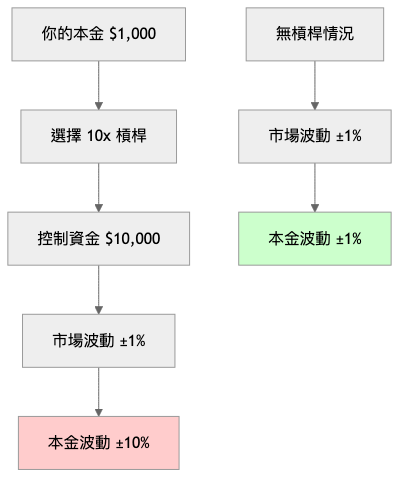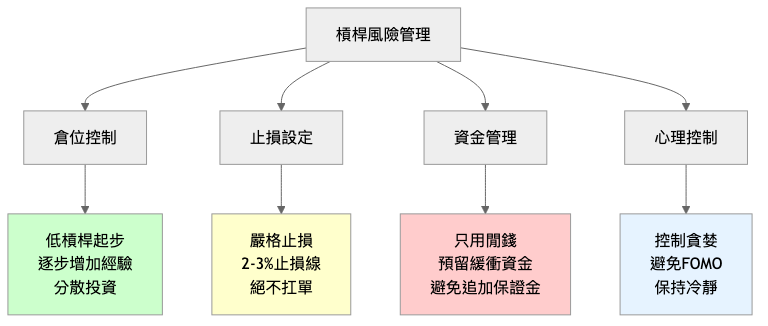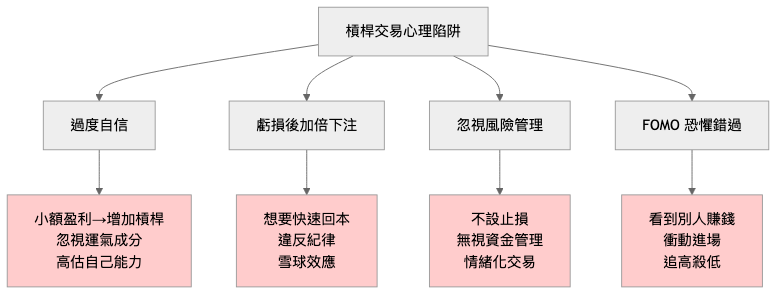今天要深入了解期貨合約中的兩個重要概念:槓桿和資金費率。這就像農業中的借貸經營一樣,爸爸有時會借錢擴大種植規模(槓桿),但借錢是要付利息的(資金費率)。理解這些機制對期貨交易至關重要!
槓桿就像是向銀行借錢來擴大投資規模:

| 槓桿倍數 | 保證金需求 | 價格變動1% | 本金影響 | 風險等級 |
|---|---|---|---|---|
| 1x (現貨) | 100% | ±1% | ±1% | 低 |
| 5x | 20% | ±1% | ±5% | 中 |
| 10x | 10% | ±1% | ±10% | 高 |
| 25x | 4% | ±1% | ±25% | 極高 |
| 100x | 1% | ±1% | ±100% | 極度危險 |
class LeverageCalculator:
"""槓桿交易計算器"""
def __init__(self, initial_capital=1000):
self.initial_capital = initial_capital
def calculate_position(self, leverage, entry_price):
"""計算槓桿倉位"""
# 可控制的名義價值
notional_value = self.initial_capital * leverage
# 可購買的數量
position_size = notional_value / entry_price
# 所需保證金
margin_required = notional_value / leverage
return {
'leverage': leverage,
'notional_value': notional_value,
'position_size': position_size,
'margin_required': margin_required,
'margin_ratio': margin_required / self.initial_capital
}
def calculate_pnl(self, leverage, entry_price, exit_price, position_size):
"""計算損益"""
# 價格變動
price_change = exit_price - entry_price
price_change_percent = price_change / entry_price
# 絕對損益
absolute_pnl = position_size * price_change
# 相對於本金的損益
capital_pnl_percent = absolute_pnl / self.initial_capital
return {
'price_change': price_change,
'price_change_percent': price_change_percent,
'absolute_pnl': absolute_pnl,
'capital_pnl_percent': capital_pnl_percent,
'leverage_multiplier': capital_pnl_percent / price_change_percent
}
def liquidation_price(self, leverage, entry_price, side='long'):
"""計算強制平倉價格"""
# 維持保證金率(通常為初始保證金的50%)
maintenance_margin_rate = 0.5 / leverage
if side == 'long':
# 做多的強平價格
liquidation_price = entry_price * (1 - maintenance_margin_rate)
else:
# 做空的強平價格
liquidation_price = entry_price * (1 + maintenance_margin_rate)
return liquidation_price
# 實際計算範例
calculator = LeverageCalculator(initial_capital=1000)
# 10倍槓桿做多 BTC
leverage = 10
entry_price = 50000
position = calculator.calculate_position(leverage, entry_price)
print(f"10倍槓桿交易分析:")
print(f"可控制價值: ${position['notional_value']:,.0f}")
print(f"可買數量: {position['position_size']:.4f} BTC")
print(f"需要保證金: ${position['margin_required']:,.0f}")
# 計算不同價格情況下的損益
scenarios = [45000, 48000, 50000, 52000, 55000]
print(f"\n價格情境分析:")
for exit_price in scenarios:
pnl = calculator.calculate_pnl(leverage, entry_price, exit_price, position['position_size'])
print(f"價格 ${exit_price:,}: 損益 {pnl['capital_pnl_percent']:.1%}")
# 計算強平價格
liquidation = calculator.liquidation_price(leverage, entry_price, 'long')
print(f"\n強制平倉價格: ${liquidation:,.0f}")

資金費率(Funding Rate)是永續合約特有的機制,用來維持期貨價格接近現貨價格:

class FundingRateAnalyzer:
"""資金費率分析器"""
def __init__(self):
self.funding_interval = 8 # 8小時收取一次
def calculate_funding_rate(self, premium_index, interest_rate=0.01):
"""計算資金費率"""
# 基礎利率(通常為0.01%)
base_rate = interest_rate / 100
# 溢價指數(期貨相對現貨的溢價)
premium_component = premium_index
# 資金費率 = 基礎利率 + 溢價組件
funding_rate = base_rate + premium_component
# 限制在 ±0.75% 範圍內
funding_rate = max(min(funding_rate, 0.0075), -0.0075)
return funding_rate
def calculate_funding_cost(self, position_value, funding_rate):
"""計算資金費用"""
# 每8小時的資金費用
funding_cost = position_value * funding_rate
# 年化成本
daily_cost = funding_cost * 3 # 一天3次
annual_cost = daily_cost * 365
annual_rate = annual_cost / position_value
return {
'funding_cost_per_period': funding_cost,
'daily_cost': daily_cost,
'annual_cost': annual_cost,
'annual_rate': annual_rate
}
def funding_arbitrage_opportunity(self, spot_price, futures_price,
predicted_funding_rate):
"""分析資金費率套利機會"""
premium = (futures_price - spot_price) / spot_price
# 如果資金費率異常高,可以考慮套利
if predicted_funding_rate > 0.001: # 0.1%
strategy = {
'action': 'funding_arbitrage',
'spot_position': 'buy',
'futures_position': 'sell',
'expected_funding_income': predicted_funding_rate,
'risk': 'basis_risk'
}
elif predicted_funding_rate < -0.001: # -0.1%
strategy = {
'action': 'reverse_funding_arbitrage',
'spot_position': 'sell',
'futures_position': 'buy',
'expected_funding_income': abs(predicted_funding_rate),
'risk': 'basis_risk'
}
else:
strategy = {
'action': 'hold',
'reason': 'funding_rate_normal'
}
return strategy
# 資金費率分析範例
analyzer = FundingRateAnalyzer()
# 計算當前資金費率
spot_price = 50000
futures_price = 50200
premium_index = (futures_price - spot_price) / spot_price
funding_rate = analyzer.calculate_funding_rate(premium_index)
print(f"當前資金費率: {funding_rate:.4%}")
# 計算持倉成本
position_value = 10000 # $10,000 倉位
funding_cost = analyzer.calculate_funding_cost(position_value, funding_rate)
print(f"每8小時資金費用: ${funding_cost['funding_cost_per_period']:.2f}")
print(f"每日資金費用: ${funding_cost['daily_cost']:.2f}")
print(f"年化費率: {funding_cost['annual_rate']:.2%}")
# 套利機會分析
arbitrage = analyzer.funding_arbitrage_opportunity(
spot_price, futures_price, funding_rate
)
print(f"套利建議: {arbitrage}")
import pandas as pd
import numpy as np
import matplotlib.pyplot as plt
def analyze_funding_rate_patterns():
"""分析資金費率模式"""
# 模擬歷史資金費率數據
dates = pd.date_range('2024-01-01', '2024-12-31', freq='8H')
np.random.seed(42)
# 生成帶趨勢的資金費率
base_rate = 0.0001
trend = np.sin(np.arange(len(dates)) * 2 * np.pi / (365 * 3)) * 0.0002
noise = np.random.normal(0, 0.0001, len(dates))
funding_rates = base_rate + trend + noise
funding_df = pd.DataFrame({
'timestamp': dates,
'funding_rate': funding_rates
})
# 分析統計特徵
stats = {
'mean_funding_rate': funding_df['funding_rate'].mean(),
'std_funding_rate': funding_df['funding_rate'].std(),
'positive_rate_ratio': (funding_df['funding_rate'] > 0).mean(),
'extreme_positive_ratio': (funding_df['funding_rate'] > 0.001).mean(),
'extreme_negative_ratio': (funding_df['funding_rate'] < -0.001).mean()
}
# 計算累積成本
funding_df['cumulative_cost'] = funding_df['funding_rate'].cumsum()
return funding_df, stats
# 執行分析
funding_data, funding_stats = analyze_funding_rate_patterns()
print("資金費率統計分析:")
print(f"平均資金費率: {funding_stats['mean_funding_rate']:.4%}")
print(f"資金費率標準差: {funding_stats['std_funding_rate']:.4%}")
print(f"正費率比例: {funding_stats['positive_rate_ratio']:.1%}")
print(f"極端正費率比例 (>0.1%): {funding_stats['extreme_positive_ratio']:.1%}")
print(f"極端負費率比例 (<-0.1%): {funding_stats['extreme_negative_ratio']:.1%}")
class ConservativeLeverageStrategy:
"""保守槓桿策略"""
def __init__(self, max_leverage=3, stop_loss=0.05):
self.max_leverage = max_leverage
self.stop_loss = stop_loss
self.position_size_ratio = 0.1 # 每次最多用10%資金
def calculate_position_size(self, account_balance, confidence_level):
"""根據信心水平計算倉位"""
# 基礎倉位
base_position = account_balance * self.position_size_ratio
# 根據信心水平調整
adjusted_position = base_position * confidence_level
# 根據槓桿計算實際控制價值
controlled_value = adjusted_position * self.max_leverage
return {
'margin_used': adjusted_position,
'controlled_value': controlled_value,
'leverage_used': self.max_leverage,
'risk_percentage': adjusted_position / account_balance
}
def risk_management_rules(self):
"""風險管理規則"""
rules = {
'max_leverage': self.max_leverage,
'stop_loss': self.stop_loss,
'max_daily_trades': 3,
'max_portfolio_risk': 0.2, # 最多用20%資金
'profit_taking': 0.1, # 10%獲利了結
'trailing_stop': 0.03 # 3%追蹤止損
}
return rules
class DynamicLeverageManager:
"""動態槓桿管理"""
def __init__(self):
self.volatility_threshold = {
'low': 0.02, # 2% 日波動
'medium': 0.05, # 5% 日波動
'high': 0.10 # 10% 日波動
}
self.leverage_mapping = {
'low': 10, # 低波動可用高槓桿
'medium': 5, # 中波動用中槓桿
'high': 2 # 高波動用低槓桿
}
def calculate_optimal_leverage(self, current_volatility, market_trend):
"""計算最優槓桿倍數"""
# 根據波動性確定基礎槓桿
if current_volatility <= self.volatility_threshold['low']:
base_leverage = self.leverage_mapping['low']
volatility_level = 'low'
elif current_volatility <= self.volatility_threshold['medium']:
base_leverage = self.leverage_mapping['medium']
volatility_level = 'medium'
else:
base_leverage = self.leverage_mapping['high']
volatility_level = 'high'
# 根據市場趨勢調整
trend_multiplier = {
'strong_trend': 1.2, # 強趨勢增加槓桿
'weak_trend': 0.8, # 弱趨勢減少槓桿
'sideways': 0.6 # 震盪市場大幅減少槓桿
}.get(market_trend, 1.0)
optimal_leverage = base_leverage * trend_multiplier
optimal_leverage = max(min(optimal_leverage, 20), 1) # 限制在1-20倍
return {
'optimal_leverage': optimal_leverage,
'volatility_level': volatility_level,
'base_leverage': base_leverage,
'trend_multiplier': trend_multiplier,
'recommendation': self._get_leverage_recommendation(optimal_leverage)
}
def _get_leverage_recommendation(self, leverage):
"""獲取槓桿建議"""
if leverage <= 3:
return "保守,適合新手"
elif leverage <= 5:
return "穩健,適合有經驗者"
elif leverage <= 10:
return "積極,需要豐富經驗"
else:
return "激進,極高風險"
# 使用範例
leverage_manager = DynamicLeverageManager()
# 分析不同市場條件下的最優槓桿
market_scenarios = [
{'volatility': 0.015, 'trend': 'strong_trend'},
{'volatility': 0.035, 'trend': 'weak_trend'},
{'volatility': 0.08, 'trend': 'sideways'}
]
for i, scenario in enumerate(market_scenarios, 1):
result = leverage_manager.calculate_optimal_leverage(
scenario['volatility'], scenario['trend']
)
print(f"\n情境 {i}:")
print(f"波動率: {scenario['volatility']:.1%}")
print(f"趨勢: {scenario['trend']}")
print(f"建議槓桿: {result['optimal_leverage']:.1f}x")
print(f"建議: {result['recommendation']}")

class LeverageBestPractices:
"""槓桿交易最佳實踐"""
@staticmethod
def risk_management_checklist():
"""風險管理檢查清單"""
checklist = {
'before_trading': [
'確定交易計劃和策略',
'設定清晰的止損點',
'計算最大可承受損失',
'確保充足的保證金緩衝',
'檢查市場流動性'
],
'during_trading': [
'嚴格執行止損',
'避免情緒化決策',
'不要臨時改變計劃',
'監控保證金水平',
'記錄交易決策原因'
],
'after_trading': [
'分析交易結果',
'檢討決策過程',
'更新交易日誌',
'評估策略有效性',
'準備下次交易'
]
}
return checklist
@staticmethod
def leverage_selection_guide():
"""槓桿選擇指南"""
guide = {
'beginner': {
'recommended_leverage': '1-3x',
'max_position_size': '5-10%',
'focus': '學習和經驗累積',
'goal': '保本並理解機制'
},
'intermediate': {
'recommended_leverage': '3-5x',
'max_position_size': '10-15%',
'focus': '策略開發和優化',
'goal': '穩定獲利'
},
'advanced': {
'recommended_leverage': '5-10x',
'max_position_size': '15-25%',
'focus': '風險收益最佳化',
'goal': '最大化風險調整後收益'
},
'professional': {
'recommended_leverage': '可變',
'max_position_size': '根據策略調整',
'focus': '複雜策略和套利',
'goal': '絕對收益和風險控制'
}
}
return guide
# 展示最佳實踐
practices = LeverageBestPractices()
print("槓桿交易風險管理檢查清單:")
checklist = practices.risk_management_checklist()
for phase, items in checklist.items():
print(f"\n{phase.upper()}:")
for item in items:
print(f" ☐ {item}")
print("\n\n槓桿選擇指南:")
guide = practices.leverage_selection_guide()
for level, details in guide.items():
print(f"\n{level.upper()}:")
for key, value in details.items():
print(f" {key}: {value}")
今天我們深入學習了期貨合約中的槓桿和資金費率機制,就像學會了農業借貸經營的精髓。重要概念包括:
槓桿交易要點:
資金費率機制:
風險管理策略:
心理素質培養:
記住爸爸說過的話:「借錢種田能放大收益,但也可能讓你傾家蕩產」。槓桿交易也是如此,必須謹慎使用,量力而行!
明天我們將探討回測、虛擬單和上線的完整流程,學習如何系統性地開發和部署交易策略。
下一篇:Day 22 - 探討回測、虛擬單、上線
